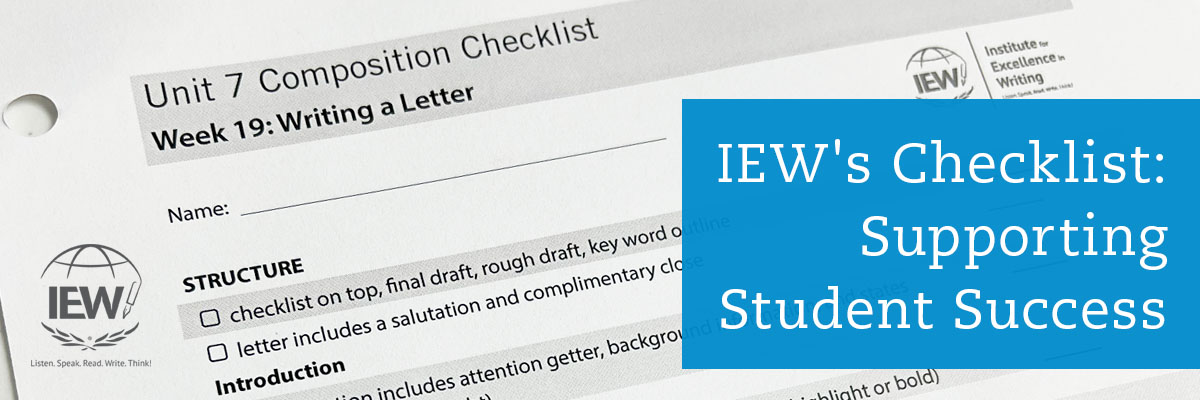
IEW’s Checklist: Supporting Student Success*
One question we hear often regards the checklist. Many teachers wonder if they really have to hold their students to the checklist of dress-ups and sentence openers, mostly because they are tired of the complaints. Kids moan either that it is too hard or that it messes up their writing. The answer is yes; it is important to require the techniques on the checklist, but it is equally or even more important to manage how the checklist is developed.
Two Most Important Things
In the second edition of Teaching Writing: Structure and Style, Andrew Pudewa lists "Two Most Important Things" in reference to teaching the syllabus of style. Most Important Thing #1 is that Andrew does not believe, nor does he teach that having all the dress-ups, sentence openers, decorations, and other advanced techniques makes for "good writing."
That being said, he does make his students apply the checklist to every paragraph they write so they can practice and develop mastery. Using each of the stylistic techniques is a technical skill, and that skill requires practice. After a period of time—usually several years—students may graduate from the checklist because they have demonstrated mastery of it. However, if they are released from the checklist prematurely, they will miss out on that crucial training in the skill.
The Most Important Thing #2 is the one that tends to get ignored: Don't introduce the stylistic techniques the way they are presented in the TWSS seminar—all at one time and too quickly, such that there is groaning and pain. Instead, follow the EZ+1 formula. “EZ” means that the technique is easy for the student. He or she can do it without much help, and it “doesn't sound too goofy most of the time,” as Andrew Pudewa memorably puts it. When the skill becomes easy, teach another technique. That is the +1 part of the formula. Everything else on the checklist should be easy for your students. Only one thing should be hard.
Andrew cautions, "If your students ever say, 'Oh, this checklist is so hard; do I have to do everything?' what they are really saying is, 'You have taught me too much, too fast.' They are overwhelmed. But if you follow the EZ+1 formula, they are unlikely to become overwhelmed because they are only doing what is easy with one new technique to practice."
The dress-ups start with the -ly adverb requirement. That should be the only requirement on the checklist until approximately 75 percent of your students can do it without much help, and “it doesn't sound too goofy most of the time.” As students practice the -ly adverb over the next few lessons, you can introduce the who/which clause, but do not add it to the checklist yet. Modeling is crucial. Show your students how the who or which clause can be used to combine two lines of fact from the outline or to add information. Brainstorm ways to add a who/which to the piece your class is working on. Invite students to try one if they wish, but do not require it yet. When the -ly adverb is easy, this is the time to add the who/which clause to the checklist.
Now students have those two dress-ups on the checklist (one easy, one hard) until they find it easy to get the who/which clause in there. Only then do they have the next dress-up (usually the strong verb) added to the list.
Teachers need to remember that there is no hurry to get through the syllabus in style. Students will have years to work through it, so take your time. If you rush the process, all you'll get is frustration on the part of your students. It will not help them master the list faster. If anything, it will slow learning down because it kills the joy.
Teaching Tips for Happier Students
Those of us who have been teaching IEW’s method successfully over the years have had amazingly few complaints. The reason for this is that we have done our best to follow Andrew's teaching tips, which we have gleaned from his dozens of talks, from our experiences using IEW’s system in our classrooms, and from hearing from other teachers as they implement Structure and Style with their students. Here are a few points that we have found most helpful in relation to the checklist:
1. Model the addition of style with each and every outline, especially in the elementary grades and whenever you’ve introduced a new or an advanced technique or are working with English Learners or students with language-based learning disabilities at any grade level. When you have finished helping your students create an outline for writing, take a few minutes to brainstorm ideas in relation to the source text for each and every required dress-up or other stylistic technique. That way when the students go to write, they already have several options to use.
2. When you feel ready, you can adjust the checklist to differentiate expectations for some of your students. There are several ways to accomplish this. If you have stronger students who are mastering each new dress-up quickly and are ready for more, take their checklist up a notch by adding the next dress-up before the rest of the class is required to use it. For example, if the -ly adverb is easy, customize a checklist for your students who are ready for more by adding the who/which clause. As the year progresses, this group may always be one or two stylistic techniques ahead of the majority of your students. This keeps them motivated and engaged and helps them to make progress at their readiness level.
In the same way if you have a few students who are not ready to move on with the rest of the class, you can take the current checklist down a notch so that they are not overwhelmed with too many new things to use. Once most of your students are using the -ly adverb successfully, then you will be ready to add the who/which clause on their checklist. However, at that point perhaps several of your students still struggle to use an -ly adverb easily. This is not the time to give them an additional dress-up requirement. While the checklist for the rest of your class has two dress-up requirements on it, the checklist for your struggling students still has just the -ly adverb. Continue to help these students as much as needed until they are ready to move on.
Some teachers prefer a three-checklist system while others feel that two works best for them. Choose what works best for your class. Simply add the next stylistic technique when most of the students are ready, moving students up to a more advanced checklist as they are able, and continue to help and support your students who need more time by giving them fewer requirements.
A word of caution, though, is this: Avoid trying to create individual checklists for every student. In theory this sounds appealing, but it can quickly become overwhelming and unmanageable for busy teachers.
3. Also avoid moving your students to independence too soon. Model each dress-up or sentence opener explicitly and extensively, and brainstorm lots of options during the writing lesson. As Andrew often remarks, “You can’t help a student too much. When they no longer need your help, they will let you know.”
Running with Weights
If you follow the EZ+1 rule and adjust the checklist for stronger and struggling students, most students will not find the checklist particularly hard because it has been developed slowly over time with their needs in mind. However, when the list gets pretty long, the groaning might begin. In his courses for advanced students, Andrew often uses an analogy that you may borrow. He tells his students that continuing to follow the checklist is like "running with weights" because it builds your writing abilities so as to make future writing easier.
The Internalized Checklist: A Tool for Life
In high schools where the Structure and Style method was implemented in grades K–8 consistently and with fidelity, students who have mastered all the stylistic techniques might be ready to “graduate” from the checklist. Frequently, however, students arrive at high school without having had any prior Structure and Style writing experience and are unprepared for the rigorous assignments introduced to them. In this case students should be required to use a checklist to provide the support and accountability they need as they learn to use the techniques correctly until mastery is achieved.
The ultimate goal is that students internalize the checklist so that when they leave your classroom or school, they carry it in their minds, prepared to employ the wide variety of stylistic techniques they have at the ready. If you follow the EZ+1 rule and adjust the checklist for your advanced students and those who need more support, your students will develop a plethora of tools for writing, making the checklist truly an instrument for a lifetime of engaging and effective written expression!
*original post by Jill Pike (2017) adapted by Jean Nichols.
|
Jean brings 34 years of classroom experience to IEW, having taught grades 1–6 in New York, Virginia, and in California, where she taught sixth-grade language arts in the Rocklin Unified School District. She was introduced to IEW in 2001 when a colleague shared Student Writing Intensive videos at weekly school staff meetings. As a result of student progress and teacher enthusiasm at her school, RUSD brought Andrew Pudewa to Rocklin many times over the next several years to train district teachers, resulting in improved student writing and test scores district-wide. Named Rocklin’s “Elementary Teacher of the Year” in 2001, Jean was also included in the 2004 and 2005 editions of Who’s Who Among America’s Teachers. |

